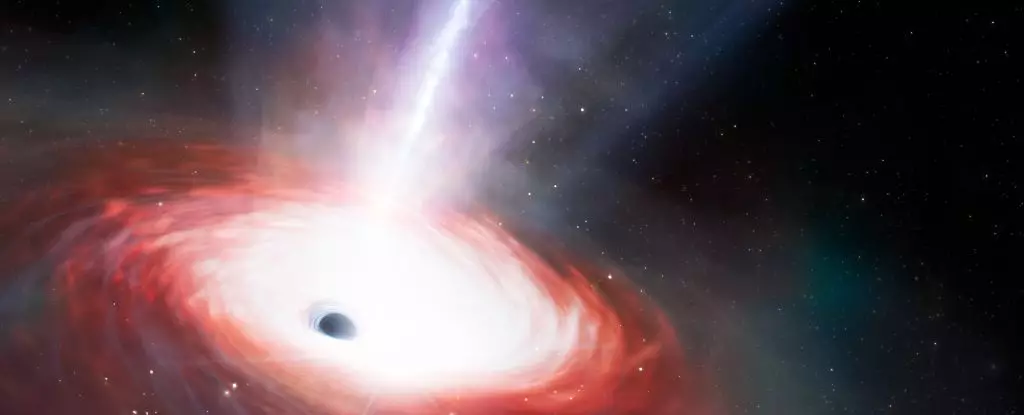In the vast cosmos, one of the most captivating mysteries is why supermassive black holes exist in such large numbers just a few billion years after the Big Bang. The discovery of a supermassive black hole within a galaxy dubbed LID-568, dated to only 1.5 billion years post-Big Bang, has added a significant piece to this cosmic puzzle. This black hole is feeding at an alarming rate, consuming material over 40 times faster than the Eddington limit, a threshold that typically governs accretion rates for black holes. This extraordinary finding not only challenges existing models of black hole formation but also offers new insights into the mechanisms at play in the early Universe.
The Eddington limit can be succinctly described as the balance between gravitational forces pulling matter into a black hole and the radiation pressure emitted from accreting material. This pressure creates an outward force that, at extreme levels, can halt further material from falling in. When a black hole surpasses this threshold, it enters what astronomers refer to as the “super-Eddington” regime. Within this state, black holes can consume more matter than traditionally predicted, igniting a cascade of energy that illuminates their surroundings. The black hole in LID-568 exemplifies this phenomenon, as its accretion disk radiates light that is disproportionate to its mass, suggesting an aggressive feeding strategy that defies typical astrophysical expectations.
Analyzing the LID-568 Discovery
Led by astronomer Hyewon Suh of the Gemini Observatory, a team of researchers utilized the James Webb Space Telescope (JWST) to conduct follow-up studies on various galaxies identified by the Chandra X-ray Observatory, particularly those radiating high levels of X-rays while appearing dim in other spectra. The process of locating LID-568 proved challenging due to its faintness, yet innovative application of the integral field spectrograph on JWST’s NIRSpec allowed researchers to pinpoint its position accurately. What they uncovered was astonishing: a relatively small black hole, weighing in at approximately 7.2 million solar masses, was exhibiting luminosity levels far exceeding expectations for a black hole of its size. This anomaly directly indicates that LID-568 is indeed a super-Eddington accretor.
The findings surrounding LID-568 push current astrophysical models by suggesting that the conventional view of black hole formation—where they form primarily from the collapse of massive stars—might not encompass the entire picture. Instead, this black hole may have formed through methods that include direct gravitational collapse of dense gas clumps. As such, supermassive black holes could have had a significant head start in their growth, assimilating mass rapidly in a thirst-laden manner.
This discovery of super-Eddington accretion patterns raises crucial questions about the lifecycle of galaxies and their central black holes. How do feeding processes affect the composition and evolution of a galaxy? It hints at a deeper interconnectedness between black holes and their host galaxies, suggesting that the former may play a vital role in regulating star formation and galaxy dynamics.
The implications for cosmology are immense, as LID-568 serves as a rare observational target that could enhance our comprehension of black hole growth and evolution in the early Universe. By observing such objects, scientists hope to develop a more robust framework for understanding how these massive entities came to be so prevalent in the cosmos. With each new observation, we can piece together the intricate tapestry of cosmic history, revealing the forces that sculpt our Universe.
Moreover, understanding super-Eddington accretion will likely shed light on the conditions necessary for forming the earliest black holes, allowing for a better grasp of the gravitational forces and interstellar conditions present in the nascent cosmos. As researchers continue to explore the incredible dynamics at play, LID-568 serves not merely as a curiosity but as a portal into understanding how the very fabric of the universe has evolved since its inception.
The supermassive black hole within LID-568 represents an extraordinary case that may help illuminate the early Universe’s enigmatic behavior. Its voracious appetite for mass at super-Eddington rates challenges traditional astrophysical models, rewriting our understanding of black hole formation and growth mechanisms. As astronomers embark on future observations, we stand on the cusp of unraveling the remarkable secrets that lie hidden in the dark, at the heart of these cosmic giants. Through continued exploration, the mysteries of our Universe may gradually transform into knowledge, illuminating the path from the Big Bang to the vast cosmos we observe today.

